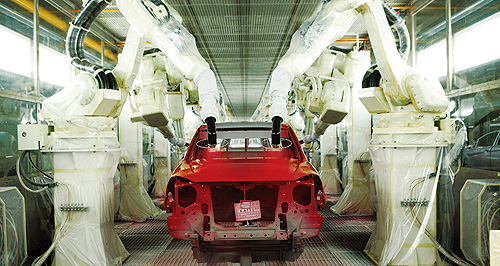Make / Model Search
News - General News - PartsAsia’s ‘Detroit’ needs Australian parts makersPromoting efficiency: Thai Board of Investment deputy secretary general Duangjai Asawachintachit Severe labour shortage opens up production opportunities in Thailand13 Mar 2013 By IAN PORTER THAILAND’S plan to become the “Detroit of Asia” has worked almost too well, with manufacturers and parts suppliers struggling to find the labour to fill production lines. But instead of deterring Australian parts makers from taking the leap into Thailand, Thai authorities say this is just the sort of environment where Australian parts makers can thrive. They argue that Australian companies have, over decades, learned how to do more with less, and how to be productive with minimal resources. This is what Thailand needs, now that labor is becoming scarce, said Duangjai Asawachintachit, the deputy secretary general of the Thai Board of Investment. “With the labour shortage, we are trying to encourage people to replace existing machinery so they can be more efficient,” Miss Asawachintachit said. The labour shortages are most apparent around what is termed Thailand’s “eastern seaboard”, an area on Thailand’s east coast less than two hours from Bangkok where many industrial estates have established. “One of the measures we have been using is we offer additional tax incentives to companies that want to do automation,” Miss Asawachintachit said. “But the companies have to prove to us they would be more efficient and reduce the number of workers.” The extra tax break on more efficient machinery comes on top of the range of tax and other incentives offered to start-up companies. These include an exemption or reduction of import duties on machinery, raw materials, double tax deductions for the costs of transportation, electricity and water and an extra 25 per cent depreciation on installation and construction costs. There has been a reasonable response from the Australian industry, with about 20 companies establishing operations in Thailand, some to feed their Australian plants and others to supply major manufacturers based in Thailand. However, Miss Asawachintachit believes more Australian companies should go to Thailand. “The volume of Australian investment has increased, but I think we could do better. We still need to do more to make sure Australian companies are aware of the business opportunities here,” she said. She pointed out it would be in their best interests, given the state of the Australian automotive industry. “(This is) particularly in a situation where the market here in this part of the world is growing and Australian companies are looking for additional markets to compensate for decline in domestic market in certain industries.” The difference between the Thai and Australian automotive sectors could not be starker. In the wake of the 2007-08 global financial crisis and the flight from large cars, Australian production has slumped to 220,000 vehicles in 2012, the same as in 1960. Meanwhile, output in Thailand has jumped. Despite periodic floods, output has risen from 1.4 million vehicles in 2008 to 2.4 million last year, 11 times the size of the Australian industry. About half the Thai industry’s output was exported, with a major slice coming to Australia in the form of Toyota HiLux, and Ford Ranger/Mazda BT50 utes, and increasing numbers of small cars. In 2012, Thailand exported 170,000 vehicles to Australia, taking about 17 per cent of the total market and almost matching the output of Australia’s three domestic car-makers. And the growth is expected to continue for a while yet as new factories come up to speed. Thailand’s Board of Investment expects output to reach 3 million vehicles by 2017. By then, a new era of growth will have opened, following the start of operations under the Asean Economic Community (AEC) agreement, which will commence in 2015. Thailand exports about 50 per cent of its production while the rest is sold on Thailand’s domestic market, where the population is around 66 million people -- three times Australia’s population. After 2015, exports are expected to grow strongly as the AEC will give Thai manufacturers access to Asean countries and a population exceeding 600 million people. “The AEC will provide opportunities for companies wanting to serve the growing market because, with no trade barriers, your product would become more competitive,” Ms Asawachintachit said. “It will improve the efficiency of the supply chains because you will not have to pay tax. “Australian companies are looking for new markets and it is much better to look at 600 million rather than 65 million people,” she said.  Read more |
Click to shareGeneral News articlesResearch General News Motor industry news |











Facebook Twitter Instagram